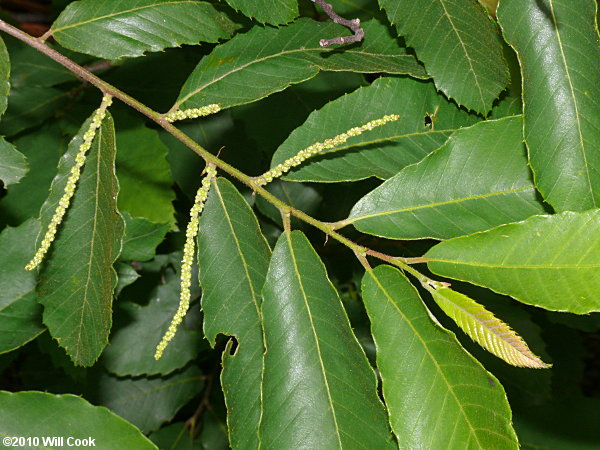Dwarf chestnut
(Castaneda pumilla)

Description
Castanea pumila, commonly known as the Allegheny chinquapin, American chinquapin (from the Powhatan) or dwarf chestnut, is a species of chestnut native to the southeastern United States. The native range is from Maryland and extreme southern New Jersey and southeast Pennsylvania south to central Florida, west to eastern Texas, and north to southern Missouri and Kentucky. The plant's habitat is dry sandy and rocky uplands and ridges mixed with oak and hickory to 1000 m elevation. It grows best on well-drained soils in full sun or partial shade. It is a spreading shrub or small tree, reaching 2–8 m in height at maturity. The bark is red- or gray-brown and slightly furrowed into scaly plates. The leaves are simple, narrowly elliptical or lanceolate, yellow-green above and paler and finely hairy on the underside. Each leaf is 7.5–15 cm long by 3–5 cm wide with parallel side veins ending in short pointed teeth. The flowers are monoecious and appear in early summer. Male flowers are small and pale yellow to white, borne on erect catkins 10–15 cm long attached to the base of each leaf. Female flowers are 3 mm long and are located at the base of some catkins. The fruit is a golden-colored cupule 2–3 cm in diameter with many sharp spines, maturing in autumn. Each cupule contains one ovoid shiny dark brown nut that is edible. The Allegheny chinquapin is closely related to the American chestnut, Castanea dentata, and both trees can be found in the same habitat. Allegheny chinquapin can be distinguished by its smaller nut (half the size of a chestnut) that is not flattened (chestnuts are flattened on one side). The leaves of the Allegheny chinquapin are smaller than the American chestnut and have less distinct teeth. Allegheny chinquapin, however, is less susceptible to the chestnut blight fungus that devastated the American chestnut. While the chinquapin does blight to some degree, it continues to send out suckers that will produce fruit. Chinquapins are quite vulnerable nevertheless, and there are many reports of heavily diseased and cankered trees. Chinquapins are used in landscapes for the purpose of attracting wildlife. When the base of plant is cut or wounded at ground level the plant will grow multiple stalks producing a thick cover used by turkeys. The nuts are consumed by squirrels and rabbits while white tail deer graze upon the foliage.
Taxonomic tree:







